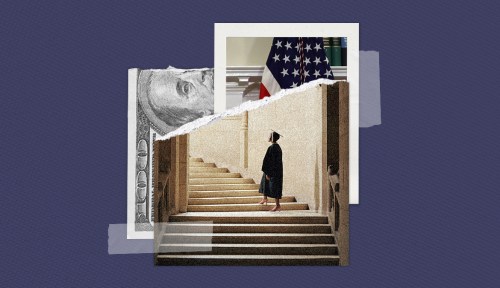What President Biden’s Student Loan Forgiveness Plan Means for You—And Who Qualifies
A new student loan debt forgiveness plan from the Biden Administration cancels up to $20,000 in debt for borrowers. Here's what to know.

Addressing the student loan debt crisis was one of the signature promises of President Joseph R. Biden’s campaign in 2020. And for good reason: Currently, Americans owe about $1.75 trillion dollars in student loans. Each borrower owes an average of $28,950 in debt. It’s a massive issue that affects the finances and well-being of millions of Americans. And with federal student loan payments previously set to resume on September 1, 2022 after many pandemic-induced extensions, many people have been nervous about what would happen to their finances after years of not having to pay their loans.
However, today it seems like there will finally be some additional relief for some of those saddled with student debt. President Biden announced a three-part plan to address the student loan crisis—with the goal of helping those currently affected by debt as well as addressing some of the worst aspects of the current student loan system.
What’s promised in Biden’s Student Debt Relief Plan
Under the new plan, the Department of Education will cancel up to $20,000 of debt for eligible Pell Grant recipients, and up to $10,000 for people who do not have Pell Grants. People are eligible for this debt cancellation if their income is less than $125,000 per year (or $250,000 if they’re married). According to CNBC, at least 9 million borrowers could have their debt completely erased by this plan.
The plan includes other measures to support borrowers, including:
- The pause on federal student loan repayment will be extended one more time, through December 31, 2022.
- A cap on monthly undergraduate student loan payments at 5 percent of a borrower’s income (half of the rate that most borrowers pay, according to the White House.)
- Proposing a new rule that borrowers who have worked at nonprofits, in the military, or in federal, state, tribal, or local governments also receive credit toward loan forgiveness.
The announcement still falls short of what other advocates of student debt forgiveness wanted—$50,000 canceled for each federal student loan borrower. That said, it’s still a positive step forward, and likely a relief for millions of Americans struggling to repay their student loan debt. It’s also worth nothing that the Biden administration has previously taken other steps to cancel roughly $32 billion of student loan debt, including for those who attended former for-profit colleges and severely disabled borrowers.
“President Biden has taken a giant step forward in addressing the student debt crisis by cancelling significant amounts of student debt for millions of borrowers. The positive impacts of this move will be felt by families across the country, particularly in minority communities, and is the single most effective action that the president can take on his own to help working families and the economy,” said Senators Chuck Schumer (NY) and Elizabeth Warren (MA) in a joint statement on Twitter. The two Democratic Senators have relentlessly lobbied the President for student debt loan forgiveness over the past two years.
How do I know if I qualify—and how do I apply?
According to the Federal Student Aid (FSA) website, here’s how to know if you’re eligible for the forgiveness program:
First: Do you have unpaid federal student loans that you still owe?
Next: Do you earn less than $125,000 per year? (Or if you’re married, less than $250,000 per year?)
If you answered yes to both questions, you will qualify for this debt forgiveness program.
How much debt is forgiven depends on whether or not you’ve ever received a Pell Grant (a federal, undergraduate grant for very low-income students). If you have debt and were a Pell Grant recipient in college, you can get up to $20,000 in debt relief. If you did not receive a Pell Grant in college, you’re eligible for up to $10,000 in student loan debt forgiveness.
The FSA says that around 8 million borrowers might get relief automatically, without having to do anything, because the Department of Education already has their income data that would help determine eligibility status. But an application will be released in a few weeks for those who don’t have their income data on file (or don’t know if they do), per FSA. For updates on when this application is live, subscribe to email updates from the Department of Education here.
Sign Up for Our Daily Newsletter
Get all the latest in wellness, trends, food, fitness, beauty, and more delivered right to your inbox.
Got it, you've been added to our email list.








